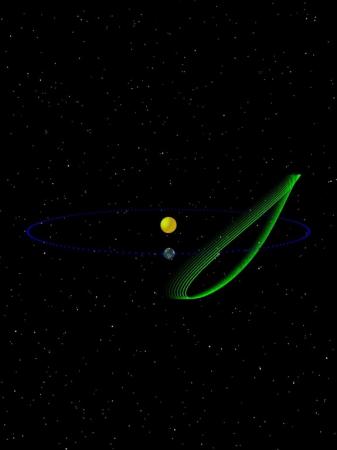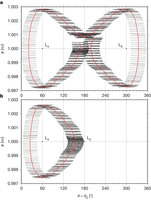摘要:200多年前,数学家拉格朗日预测到被称为“特洛伊”小行星的天体的存在。它们是一些小型天体,如果其保持在一个行星轨道之前或之后60°的“三角点”附近的话,那么它们便能够稳定地与这个行星共享轨道。木星有数千个“特洛伊”小行星;火星和海王星也有一些。现在,地球也被发现有一个“特洛伊”小行星。对NASA的“广域红外巡天探测器” (WISE)卫星收集的数据所做的一次搜索显示,小行星2010 TK7是一个可能性很大的候选对象,而随后的光学观测则证实了它作为地球的一个“特洛伊”伙伴的地位——它绕L4(前)拉格朗日三角点做振荡运动。本期封面所示为想象出的小行星2010 TK7在过去165年的运动情况,是从地球轨道之外和之上一个有利的点观测时应能看到的情形。

NASA通过广角红外线探测望远镜卫星(WISE)发现第一颗地球的特洛伊小行星2010TK7,这颗小行星在地球前方8000万公里处。图中绿线为该小行星轨道.
生物探索推荐英文论文摘要:
Nature 475, 481–483 (28 July 2011)
Doi:10.1038/nature10233
Earth’s Trojan asteroid
Abstract:
It was realized in 1772 that small bodies can stably share the same orbit as a planet if they remain near ‘triangular points’ 60° ahead of or behind it in the orbit. Such ‘Trojan asteroids’ have been found co-orbiting with Jupiter, Mars and Neptune. They have not hitherto been found associated with Earth, where the viewing geometry poses difficulties for their detection, although other kinds of co-orbital asteroid (horseshoe orbiters and quasi-satellites) have been observed. Here we report an archival search of infrared data for possible Earth Trojans, producing the candidate 2010 TK7. We subsequently made optical observations which established that 2010 TK7 is a Trojan companion of Earth, librating around the leading Lagrange triangular point, L4. Its orbit is stable over at least ten thousand years.

Figure 1: Orbital parameters of asteroid 2010 TK7.

Figure 2: Semimajor axis versus relative longitude for 2010 TK7.







